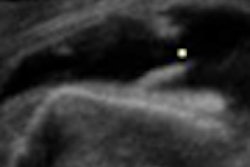Sonohysterography offers high sensitivity and specificity for diagnosing endometrial and endocavitary pathology in both premenopausal and postmenopausal women, according to research from Case Western Reserve University in Cleveland.
"[Sonohysterography] is a useful procedure for triaging patients with abnormal uterine bleeding, but also for other endocavitary lesions in differentiating the focal ones from diffuse abnormalities," said Dr. Flamur Semaj.
The Case Western researchers performed a retrospective study, evaluating both premenopausal and postmenopausal women from 2003 to 2006 who presented with abnormal uterine bleeding or infertility. Of the 58 women included in the study, 43 were premenopausal and 31 presented with abnormal bleeding. Nine of the 31 patients with abnormal bleeding had infertility, while three had recurrent abortions.
The 15 postmenopausal women all presented with abnormal bleeding, Semaj said. He presented the research during a talk at the 2008 American Institute of Ultrasound in Medicine (AIUM) meeting, held earlier this year in San Diego.
All 58 patients initially underwent transvaginal sonography; patients with indeterminate endometrial findings then received sonohysterography. The sonohysterography study took approximately 10 to 15 minutes. There were no complications, with the exception of mild postprocedure pain, according to Semaj.
The researchers then compared the findings on sonohysterography with findings on hysteroscopy and endometrial biopsy.
Thirty-two patients had a normal endometrial lining and 26 had abnormal findings. These findings included polyps in 11 patients, submucosal fibroids in eight patients, endometrial hyperplasia in three patients, intrauterine synechiae in three patients, and adenomyosis in one patient. Of the 15 postmenopausal women, three had polyps, two had endometrial hyperplasia, and 10 had a normal endometrial lining, according to the researchers.
Transvaginal sonography yielded sensitivity of 72% and specificity of 65%, compared with 100% sensitivity and 94% specificity for sonohysterography, Semaj said.
Some pitfalls of sonohysterography included inadvertent injection of air during installation of saline into the endometrial cavity, inadequate distension due to saline leak, and blood clots in the endometrial cavity, he said.
Semaj acknowledged some limitations of the study, including its retrospective nature and the small number of patients.
Nonetheless, sonohysterography is a simple, minimally invasive procedure that provides high sensitivity and specificity for focal endometrial and endocavitary lesions, Semaj said.
By Erik L. Ridley
AuntMinnie.com staff writer
July 25, 2008
Related Reading
Sonohysterography-guided biopsy is effective in endometrial pathology, May 5, 2008
Saline infusion sonohysterography effective for infertility workup, December 29, 2006
3D: Rendering a new era, May 2, 2005
Studies bolster sonography's value for abnormal gynecological bleeding, November 5, 2004
3D ultrasound poised to revolutionize pelvic imaging, September 9, 2004
Copyright © 2008 AuntMinnie.com




















